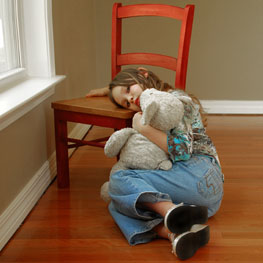
In today’s society, anxiety disorders are on the rise in both kids and adults. It’s the number one reason why parents bring a child to a mental health professional. These are stressful times, and kids are exposed to more and more information about the scary and dangerous aspects of being human. Today’s parents are also more anxious and depressed than ever, and anxious parents, unfortunately, tend to raise anxious kids.
Despite this increase in anxiety disorders, it’s important to remember that some worry is normal, and it’s important to know the difference. As kids grow and step into new experiences, they should have questions and uncertainties. Normal worry becomes problematic worry when a child is consistently avoiding activities or experiences that are a normal part of development: Going to school, visiting friends or falling asleep. A fearful and often dramatic refusal to try anything that is not familiar and predictable is another warning sign, as well as an excessive need for reassurance - a pattern of constant questioning that never fills the bottomless pit of worry.
When a child suffers from anxiety - or is even just showing the early signs of avoidance and excessive worry - there are two consistent mistakes that both parents and schools make. Both are done lovingly and intuitively because they appear to work in the short run, but the result is that anxiety gets stronger. The first mistake is trying to meet anxiety’s demand for certainty. Parents hope to alleviate worry by continually reassuring, planning for or accommodating their anxious child.
Second, when this fails - because absolute certainty is impossible - parents then allow the child to avoid important activities. Although parents believe they are helping their children by keeping them calm and comfortable, the more anxious children avoid, the more they become trapped by their anxiety. Their world becomes smaller and smaller. Because anxiety looks dramatic, it’s often overwhelming for families who don’t understand it. The good news? It’s actually not complicated.
Here are a few key points to help interrupt anxiety.
First, the content of the worry may jump around - from the fear of throwing up to the insecurity of not fitting into a social group - but the process of anxiety is virtually the same every time. It does the same thing over and over, and once families recognize its tricks, it begins to lose its power. Its main trick is to convince children and parents that they must feel certain and confident before they try something new. Instead, we should expect worry to show up when doing something new or different or challenging. Our job as parents is to encourage children to step into the uncertainty of life, not away from it. Knowing how to respond to worry - not how to eliminate it - is the key.
Parents can begin to teach this new response to worry by externalizing the ‘worry part’ with kids. Make it a character! Give it a name! Talk back to it! If a parent is also a worrier and the family is working together on managing worry, then parents can name their own worry too. Parents serve as important role models for how to respond to an anxious moment, so it can be quite helpful for parents to exhibit the turmoil of their worries, as long as they allow their children to witness them recover by ‘talking back’ to the worry and problem-solving. For example, kids benefit when they hear a parent say something like, “Geesh, my anxiety really got the best of me that time. I was listening to him and completely forgot to step back and problem solve. I’ll keep working on it… next time worry shows up, I won’t let him boss me around. And if you see my worry show up, let me know!”
Anxious parents in particular can have a hard time letting their kids be uncomfortable. When a child is struggling with normal fears or worries, anxious parents may tend to step in too quickly. They often want to protect their child from the similar worries and struggles that they had as an anxious child. And what parent wouldn’t? Nonetheless, anxious families need a whole new framework that sees uncertainty as a healthy first step toward problem-solving and confidence. Here’s the critical shift: If you’re uncertain or uncomfortable as you move into new situations and challenges, you’re on the right track.
Lynn Lyons, LICSW, and Reid Wilson, Ph.D., are the authors of two books that help anxious families: Anxious Kids, Anxious Parents: 7 Ways to Stop the Worry Cycle and Raise Courageous & Independent Children and Playing with Anxiety: Casey’s Guide for Teens and Kids. Information about both books and the authors can be found at www.playingwithanxiety.com.
Calgary’s Child Magazine © 2024 Calgary’s Child